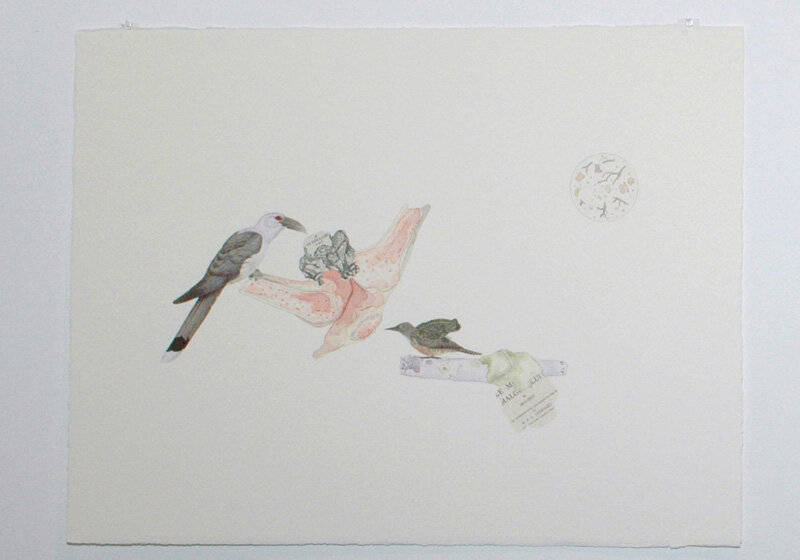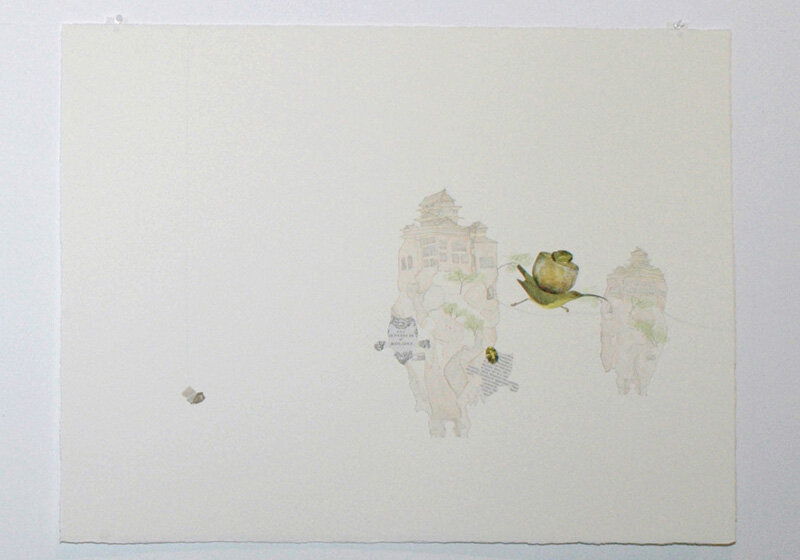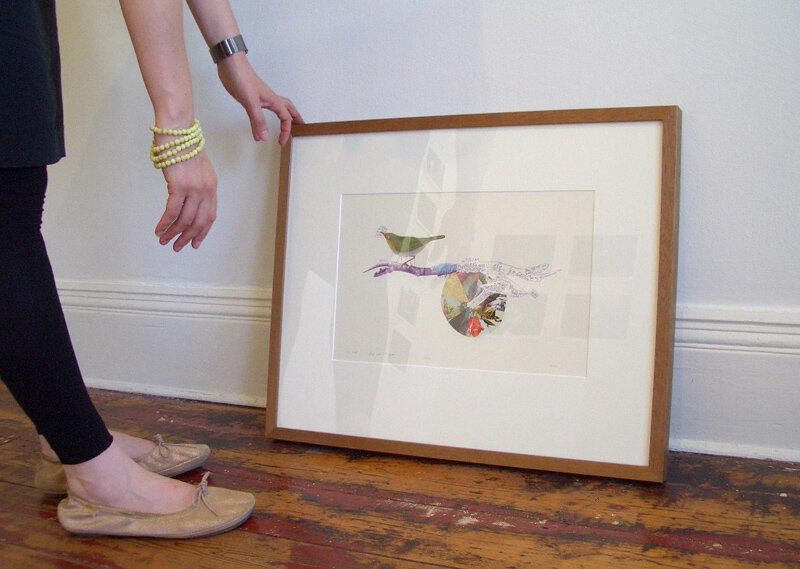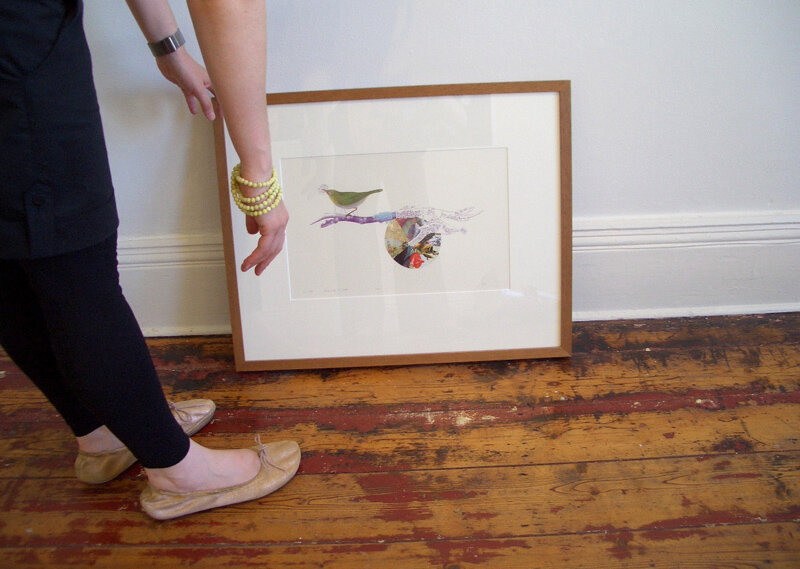FOUR EXHIBITIONS, 2001–2007
1/ Gracia Haby & Louise Jennison
There’s always underground, i (Le Médecin malgré lui)
and
There’s always underground, ii (Le Bourgeois gentilhomme)
2007
Watercolour, pencil and collage on Fabriano traditional white 640gsm paper, 56cm X 76cm
Two collaborative works on paper created especially for Tara Gilbee’s <the space in between> book project, featuring Molière’s The Doctor in Spite of Himself (Le Médecin malgré lui) and The Bourgeois Gentleman (The Middle-Class Aristocrat;The Would-Be Noble) (Le Bourgeois gentilhomme).
●
<The Space In Between>
PENELOPE AITKEN, CHRIS BOND, GABRIELLE BRAUER, RICHARD BUTLER-BOWDEN, NARINDA COOK, MARTINA COPLEY, KATE COTCHING, ANNA FINLAYSON, JUAN FORD, TARA GILBEE, ANDREW GOODMAN, MANDY GUNN, GRACIA HABY & LOUISE JENNISON, MARK HILTON, GREER HONEYWILL, LOUISE HUBBARD, PENELOPE HUNT, PAUL IRVING, ASH KEATING, WENDY KELLY, TAMARA MARWOOD, GABBY O’CONNOR, KAREN PAPECK, PATRICK POUND, ELIZABETH PRESA, KIRON ROBINSON, TRACY SARROFF, ALEX SELENITSCH,ALOMA TREISTER, MEREDITH TURNBULL, HAYLEY WEST
<THE SPACE IN BETWEEN> BOOK PROJECT
FRIDAY 13TH OF JULY – SATURDAY 4TH OF AUGUST, 2007
A GROUP EXHIBITION CURATED BY TARA GILBEE
VCA MARGARET LAWRENCE GALLERY
(TRAVELING TO)
SIDNEY MYER WORK ON PAPER GALLERY, BENDIGO ART GALLERY, SATURDAY 15TH OF MARCH – SUNDAY 13TH OF APRIL, 2008
UMBRELLA STUDIO CONTEMPORARY ARTS, FRIDAY 8TH OF AUGUST – SUNDAY 14TH OF SEPTEMBER, 2008
<the space in between> book project is an intriguing and thought-provoking exhibition that investigates the nature of books and their place within our ordinary lives. It features work by thirty-two artists from across Australia, who have each responded to the internal space of a book carved and presented to them for their artistic intervention. Curator and collaborator Tara Gilbee has spent many months collecting dozens of books, in English and foreign languages, with colourful and often decorative hard covers and infinite variations of ivory toned pages. With a scalpel and considerable care, she has carved out a section from each book: sometimes guided by the formal structure of an embossed surface, at other times led by the layout of title and text on each cover. The participating artists were presented two objects — the remnants of the book with its empty cavity, and the detachable core — with which to create a work for <the space in between> book project. The end results on exhibition represent a vast array of responses, including sculptural work, installations, and even drawn and photographic reworkings of the original volumes.
Wagga Wagga Art Gallery
<The Space In Between> later toured to Latrobe Gallery (Victoria), Wagga Wagga Gallery (NSW), and Artspace Townsville (Queensland).
“While many speak of the authority of the printed word, the allure of the book far transcends its mere containment of information. As a vestibule of hopes, dreams and the imagination, the book is an object of wonder that engenders a poetry independent of the printed text bound within. This made the challenge set down by curator Tara Gilbee in book project, for many, all the more provocative.
Gilbee, whose stewardship of the project ventured beyond the realm of curatorship and into collaboratorship, posted books to artists that she had collected and, systematically, mutilated. Receiving the remains of these books in the mail, each of the thirty-two participating artists were invited to create a new artwork that addressed ‘the space in between’ – i.e. the negative space between the body of the book and those sections that the curator had surgically removed with a scalpel.
There were some ingenious solutions to the curatorial brief. ”
2/ Gracia Haby & Louise Jennison
Not a pipit
2006
Single color lithographic offset print hand colored with pencil and collage on spicers cotton 270gsm
46cm X 26cm
Printed by Redwood Prints
JOHN ABBATE, JENNIFER BARTHOLOMEW, DAMIANO BERTOLI, SUE BOUCHER, ELIZABETH BOYCE, SANDRA BRUCE, LOUISA BUFARDECI, JEN CABRAJA, ANGELA CAVALIERI, MARTINA COPLEY, CRAIG EASTON, SIMONE EWENSON, ANNA FINLAYSON, PRUDENCE FLINT, NATASHA FRISCH, TARA GILBEE, GRACIA HABY & LOUISE JENNISON, TOBIAS HENGEVELD, HEATHER HESTERMAN, ANN HOLT, RUTH JOHNSTONE, NICHOLAS JONES, KATE JUST, DAWN KANOST, LORI-JEAN KIRK, CASSANDRA LAING, ALEX MARTINIS ROE, BRANDT MCCOOK, JULIE-ANNE MILINSKI, ANNEE MIRON, CLAIRE MOONEY, CHRISTINE MORROW, GEOFF NEWTON, PANDAROSA, ALEX PITTENDRIGH, STEPHANIE RADOK, CARLY RICHARDSON, STEVEN RENDALL, LOUISE RIPPERT, JANITA RYAN, ELISSA SADGROVE, ALEX SELENITSCH, SANDRA SELIG, HEATHER SHIMMEN, JULIA SILVESTER, LYNETTE SMITH, MASATO TAKASAKA, SALLY TAPE, NADINE RENEE TREISTER, EMMA VAN LEEST, ELKE VARGA, CARMEL WALLACE, DARREN WARDLE, GARY WHEELER, ILKA WHITE, CLARE WHITNEY, SARAH WOODS
LEXICON: AN EXHIBITION OF REWORKED PAGES FROM (A PALIMPSEST OF ACCIDENTAL EXTRACTIONS) THE CHAMBERS’S ENGLISH DICTIONARY – LONDON 1898
1ST OF AUGUST – 30TH OF AUGUST, 2006
A GROUP EXHIBITION CURATED BY MARTINA COPLEY
GALLERY @ CITY LIBRARY, 253 FLINDERS LANE, MELBOURNE
Recent work by twelve Australian artists who have a particular affinity with paper. These invited artists each explore ideas of performance, the stage and enactment through printmaking, drawing, painting, collage, artist’s books, sculpture and digital images.
Lexicon: An exhibition of reworked pages from (a palimpsest of accidental extractions) the Chambers’s English Dictionary – London, 1898
Martina Copley
Each of the artists involved have produced work every day for one month over Perfect bound with 1255 numbered pages, printed in London, 1898, bought by a friend for $20 in a second hand bookstore is an edition that now has the aura of a unique object. Signs of use and accident — stains and tears, jottings and yellow-edged pages — mark the book as integral with its material history, suggesting a world in which the reference book is now an artifact of wisdom. A communal archive of shared knowledge, symbolic of the library and its holdings, the lexicon bears witness to old belief systems still functioning through language.
The intimate boundaries of its form — finitude and sequence, repetition and extension — provide the spatial gestalt for the exhibition. Dismantled and reconstrued, its integrative internal structure sits like a collaged landscape of language. A found poem — an arbitrary gesture in the rooms of a bibliotech — the 'absent text' of the dictionary is now playfully rendered in textual, visual and material manipulations of the original pages.
Artists respond to the codified formal elements of the page — margin, head, gutter, type, text block, illustration, running head.... and to the binarism of black ink on white paper. But words seep through, along with their labyrinthine associations. There is a tension between the literal and conceptual page as artists play with the sonoric and visual aspects of language that form part of the substance of the dictionary substrate.
3/ Gracia Haby & Louise Jennison
30 days of June
2004
Thirty drawings, with pen and ink, watercolour and pencil
BFK rives 270gsm
15cm X 11cm
KELLY BOUCHER, MITHU SEN, SUSAN SHINGLES, SHERRYN MCIVOR, SUSAN PURDY, ALISON JEAN MAYER, JOSEPH BERTO, SARAH ADAMS, MARIAN CRAWFORD, RODNEY FORBES, MARK MCDEAN, GRACIA HABY & LOUISE JENNISON, MEGAN MCPHERSON, WENDY HUTCHISON
THE FOUND PROJECT
SATURDAY 18TH OF SEPTEMBER – SUNDAY 31ST OF OCTOBER, 2004
LATROBE REGIONAL GALLERY, 138 COMMERCIAL ROAD, MORWELL
Recent work by twelve Australian artists who have a particular affinity with paper. These invited artists each explore ideas of performance, the stage and enactment through printmaking, drawing, painting, collage, artist’s books, sculpture and digital images.
LIST OF WORKS
Tuesday, 1st of June
Polar bear with mandarin sections
Found: In polar ice near oceans
Wednesday, 2nd of June
Peal ex pigment, Birdwing copper
Found: Melbourne Artist Supplies
Thursday, 3rd of June
Spiny mouse with scrabble letter ‘E’
Found: Crete
Friday, 4th of June
Spinifex Hopping mouse with random European coins
Found: Sand dunes in Central Australia
Saturday, 5th of June
Cafe du Monde coffee cup rings
Found: Kitchen bench
Sunday, 6th of June
Diggers Seeds, mustard red
Found: Work bench
Monday, 7th of June
Banded mongoose
Found: Central Africa, south of Sahara
Tuesday, 8th of June
Magnetic poetry
Found: Fridge door
Wednesday, 9th of June
Emperor goose and bakelite bluebird brooch
Found: N.E. Siberia
Thursday, 10th of June
Palm Court cafe matches
Found: Decatur Street, New Orleans
Friday, 11th of June
Giant armadillo
Found: Tropical rainforest, South America
Saturday, 12th of June
Giant pouched rat with Singapore orchids
Found: South Africa
Sunday, 13th of June
Southern tamandua with Japanese animal shaped rubber bands
Found: Uruguay
Monday, 14th of June
Size 10A, carbon steel surgical blade, empty packet
Found: top drawer, bookbinding room
Tuesday, 15th of June
Omar’s cat collar
Found: Around his neck
Wednesday, 16th of June
Stephane Marais nail lacquer
Found: Bathroom cabinet
Thursday, 17th of June
European mink with a mandarin section
Found: Slow-moving river, Belarus
Friday, 18th of June
Prevost’s squirrel with a mandarin section
Found: A garden in South East Asia
Saturday, 19th of June
Band-aid
Found: Bottom of a bag
Sunday, 20th of June
Aardvark
Found: Open grassland of the Sahara
Monday, 21st of June
Asiatic mouflon
Found: On low mountain slope, W. Asia
Tuesday, 22nd of June
Black footed ferret with a slice of kiwi
Found: North America
Wednesday, 23rd of June
Nasturtium leaf
Found: By the pond
Thursday, 24th of June
Uno card, number 7, green
Found: Games box
Friday, 25th of June
Sun squirrel with silver ring
Found: Sunny spot in Senegal
Saturday, 26th of June
Yellow post-it with currency conversions
Found: hammer & daisy folder
Sunday, 27th of June
Kowari with scrabble letters ‘J’, ‘T’ & ‘Y’
Found: Central Australia
Monday, 28th of June
Tin of Fancy Feast cat food, grilled turkey
Found: Corner store
Tuesday, 29th of June
Plumed whistling-duck with sparkly red Paris brooch
Found: N. & E. Australia
Wednesday, 30th June
Sea otter
Found: Kamchatka Peninsula
Latrobe Regional Gallery is delighted to present The FOUND Project which features artists from the Gippsland region, Victoria and overseas.
Each of the artists involved have produced work every day for one month over the period August 2003 – August 2004. Working in parallel with project coordinator Kelly Boucher they have documented objects found on their daily journeys, creating small works on paper.
The Gallery is dedicated to presenting independent and innovative exhibitions and The FOUND Project highlights the commitment of the Gallery to the region and its artists.
On behalf of Latrobe Regional Gallery I would like to thank all the artists involved for their contribution to the project. My sincere thanks also go to Kelly Boucher, who initiated and coordinated the project. Her unwavering enthusiasm and commitment have ensured that the exhibition embraces a diversity of artistic styles to present a cohesive theme.
Louise Tegart
Director, Latrobe Regional Gallery
The FOUND Project catalogue essay
Penelope Trotter
Art theory lecturer, Monash University Gippsland
Collaborative art provides a staged exhibition format that enables several artists to be contributors to one large art piece. The FOUND Project documents the processes involved in such collaboration. This makes us aware that there is a whole array of things that contribute to the set up of an installation.
The FOUND Project is a purely empirical artwork based on the experience of the artist with his/her environment. Movement, change, and time are all variables that have influenced the making of this work. This shows us that objects within the world are subject to change according to the influence of many elements and cannot be pinpointed by a single conception, abstraction or meaning.
It also displays to us the fecundity of perception. Momentary perception is limited by what is there at the time. When a person finds an object, their perception of the processes of life around the object is enlivened. When the object is appropriated as part of an installation environment the processes continue.
As fifteen artists were involved in The FOUND Project there is also added the extra variable of choice. This brings us to question: what makes one person stop and choose an object as one that possesses a particular beauty or significance? This work also acts as a diary of experience for each artist. The artists have found over time that these objects have triggered memories that they may have not otherwise had.
4/ Louise Jennison
2001 — A Domestic Odyssey
2001
Wednesday 21st of February – Saturday 10th of March, 2001
MASS gallery, 142 Queens Parade, North Fitzroy
2001 — A Domestic Odyssey is a play on predictions for the 21st century as being one of technological advances that will enable us to fly our own spaceships and be masters of robots who will vacuum our houses while pouring our cocktails, as predicted in the last century. Though technology is a major part of our 21st century lives, domestic intimacy, personal relationships, and human emotion has not yet been erased.
2001 — A Domestic Odyssey is a suspended moment …. a slice of time that has captured a moment in itself.
Through the use of visual poetics and watercolour, Louise Jennison has utilised various mediums by removing them for their original high art appeal and utilising them in a momentary context. Through this she has created a transient portrait of domestic life.
This exhibition captures the spirit of a time, a place, an air of circumstance in a type of wunderkamma space — where the viewer is invited to share and perhaps compare their domestic realm in an abstraction of the human condition. In the tradition of Fluxus, Jennison dissolves the boundaries held between art and life, in 5 simple conceptual possibilities.
One hour, one day & one week are transcriptions of events written directly onto the gallery’s walls. This piece creates the action & momentum, which binds the domestic odyssey and allows its progression into the ritual of the everyday.
List of everything in our home, is a catalogue of domestic possessions. The initial impression that this piece conjures is that of one of a fastidious documentation categorised by object, written densely on water paper. However, under closer examination, the list is documented straight from the artist’s perception of the object, whilst being mechanical in its execution With this, the viewer is transported into artist’s domestic space. The objects are listed in terms of their individual appeal, not by their material or usage. In turn, List of everything in our home moves from a list of objects, to a catalogue of the subconscious relationship the owner has with that object — all those bits and pieces that makes a house into a home. The viewer is transported into the artist's space. As if you are visiting the artist's house for the first time and asked in retrospect what you may remember seeing.
Transcriptions of my travel journal is a symbol of memories which are held in a domestic space ... all those things taken from life and preserved into a certain significance through the act of keeping a diary — a personal history that is reflected upon in the familiarity of domesticity. As this ‘Hog Log’ is a travel diary of Jennison’s journey to Portugal, the domestic space is reconfirmed .... no matter how far you can travel, in terms of livability the homes provides a classic where comparisons are drawn that expose the human condition.
20.12.00 – 18.02.01 is a series of 100 water colour paintings depicting scenes of the domestic odyssey — housework, the cats, the dog, the visitors, the outings, the family …. with all their idiosyncrasies. This piece reconfirms the transcentual ritual of the domestic realm .... every moment no matter how mundane it seems is integral to the existence of the domestic system. A system which would have been predicted as defuctorary by 2001 — A Space Odyssey.
Gracie’s dreams transcribed like a List of everything in our home, communicates as another visual poetic. Jennison has transcribed Gracia’s dreams from a dictaphone into densely written text with the precursory impression being that of fastidiousness, almost mechanical in its precision. However this effect of precision counteracts the lucid and the all to human nature of the dialogue.
Good morning, I had some quite weird dreams .... guinea pig swimming in turbulent water …. um he was really tall, sort of middle aged, albino man, he stepped out and scared me …. I must have lagged behind.
All those external influences that are experienced on a day to day level, most particularly through the media, feed the subconscious and are exposed through a dream. The domestic space is a place where these fragments of our subconscious are released and at times realised.
Jennison’s aim was to portray document the daily frivolity and joy of one’s private life .... an intimacy and candid honesty (which) would reveal domestic ritual and comfort as a celebration of all that is to be human. Louise Jennison has exposed her domestic realm into a series of idiosyncrasies, which transports the viewer beyond her work. This sectional view holds the momentum of the past, distils it in a moment to communicate a consensus of its fragility and its certainty.
Due to the spread of mass literacy, to television and the transistor radio, our sensitivities have changed. The very complexity of this impact gives us a taste for simplicity, for an art which is based on the underlying images that an artist has always used to make his point …. We are asking for a new way of looking at things, but more totally, since we are more impatient and more anxious to go to the basic images. This explains the impact of Happenings, event pieces, mixed media films. We do not ask any more to speak magnificently or taking arms against a sea of troubles, we want to see it done. The art which most directly does this is the one which allows this immediacy, with a minimum of distractions ....
Emma Leigh Winterburn, 2001
Dick Higgins, extract from his Statement on Intermedia, New York, 3 August 1966




